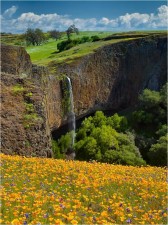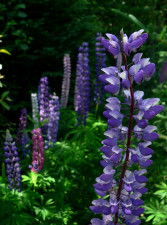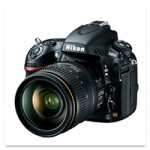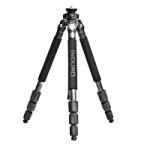
Table Mountain Blooms Exploration
Photograph the amazing spring blooms on Table Mountain – 4 Hr. – $275
-
The Exploration
Ancient Lava Fields
Both of the Table Mountains are the remainder of an ancient volcano, and ancient lava fields can still be found all over the mountain. Part of the Lovejoy Formation, the mountains are believed by some to date back to 14 million and 39 million years ago. However, the mountains are known to date back six thousand years
 Phantom Falls
Phantom FallsThe waterfall at Coal Canyon is within the North Table Mountain Ecological Reserve. The waterfall is 164 feet (50 m) high and runs off the edge of Coal Canyon, in front of a grotto. A small pool at the bottom is home to a California newt subspecies, the Coastal Range newt. As a seasonal waterfall, Phantom Falls runs only during the rainy months, late autumn to early spring. It is named Phantom Falls because it disappears during the dry season.
It is about 2 miles (3.2 km) to the waterfall, which is visible from the rim of Coal Canyon. Optionally, a strenuous downhill hike then ends at the bottom of the waterfall.
The shaft of an abandoned gold mine in the grotto behind the falls dates to the California Gold Rush. Today, there is no gold there, but research still takes place in the mine shaft.Spring Wildflowers
Table Mountain is most famous for its vast array of wildflowers, which bloom during spring time. There are several species of flowers that bloom, the most common are lupine, frying-pan poppy, and goldfields. The flowers are protected by the California Department of Fish and Wildlife, so picking them is illegal, but we are allowed to look and even touch the flowers, as long they are not damaged. Because the area has no trails, stepping on the flowers is hard not to do. It is advised that visitors are careful while trekking, so the delicate flowers are not damaged.

Wildlife
The mountain includes several wildlife species, including: the California newt, banana slugs, different frog species, several bird species, garter snakes, California Horned Lizard, and several mammal species, including Black-tailed Deer, coyotes, mountain lion, and domesticated cattle, which move around freely.
Caves
The largest cave is located at Phantom Falls, and the deepest cave is at Little Phantom Falls, and actually requires crawling. Both are located in Coal Canyon. A small cave is also located at Flag Falls and Beatson Falls. Another cave is located behind a small unnamed watertfall. The caves are made of a mixture of basalt and clay, and were created over thousands of years, as the waterfalls eroded away at the rock. The two caves at Coal Canyon are the most easily accessible, and the one at Phantom Falls is the most visited.
Cherokee Ruins
The small ghost town of Cherokee, California, is on the mountain, was once populated by the Maidu. Around 1818 Spanish explorers found gold on Cherokee’s south side near Table Mountain. In 1849 Cherokee Indians came from Oklahoma. Welsh miners came in the 1850s, naming the town after the Cherokee and constructing many buildings in town. Today only ruins remain, but the area is home to around 20 people.
Thomas Edison owned one of the mines which sprung up in the area, and he saw to it that the mines were electrified to ease the work. The town prospered during the mining period, and Butte County’s first homes with running water were built in Cherokee.Phantom Ranch
Phantom Ranch is the ruins of an ancient ranch house from the late 19th century that was used during the Gold Rush. The ranch can be seen from the Phantom Falls hike. The ranch is now completely in ruins, and the only thing left of it are a few pieces of wood where the foundation used to be.
-
What To Expect
Itinerary & Hiking – 4+ miles
We will meet in the morning for photographing flowers in their best lighting . Each location along the trail offers a variety of flowers matter and wildlife. We will break for lunch in the meadows close to our cars around 11am and to depart on the 4 mile round-trip hike to the Waterfall at 11:45 .
Group Size – 10
We have designed this trip with comfort and quality in mind. For these reasons, we have purposely limited this trip to only 10 photographers, and with 2 instructors. Having a small group allows us to be highly efficient while ensuring personal attention and the ultimate intimate educational experience.
Getting to Table Mountain
You will need to provide your own transportation to our meeting place on Table Mountain
What to Bring
Required Equipment
 DSLR Camera
DSLR CameraRequired:
Our Workshops require the consistent creative control of a Digital SLR Camera (DSLR) to get the most out of your learning experience.
We will be utilizing the camera’s Aperture Priority, Shutter Priority, and Manual modes, and multiple lenes if you have them.
We teach all brands and models of Canon, Nikon, Sony, Pentax, Fuji and more! Tripod
TripodRequired:
Tranquility and Stability are prime in Photography.
To achieve this, we many times need a sturdy tripod will help improve your compositions and get sharp images.
A tripod also allows you more time to determine what settings and focus you need to execute your creative insight.Other Things to Bring
Wireless Remote Control / Cable Release
Since we go through all the trouble to place out camera on a sturdy tripod, we would be doing our image a dis-service is we didn’t keep our hands and body motion away from the camera. A shutter release allows you to do that. This helps ensure a sharpest photo especially in long exposures in dark areas, or at night. They are very affordable to affordable and a necessary tool to have in your camera bag!
Additional Lenses
Try to cover a range from very wide (17-20mm), for landscape images, to zoom ranges (100-400mm) for wildlife. It’s not uncommon to see wildlife on workshops (even those structured for landscape instruction), so it’s best to be prepared, if possible. We also encourage you to bring other lenses, like a macro or fish-eye lens if you have them, because there are always endless creative possibilities to be found on our workshops.
Filters
We do a great deal of work with filters in our workshops, so, if you have them, bring them. We highly recommend a Circular Polarizer, and a (3 or 4) soft-step graduated neutral density (GND) filter. We also use straight neutral density filters, which will help us get longer exposures in all times of day, but this isn’t as important as the first two mentioned. We have a few extras that can be loaned out, but you’re going to love what you see with the filters, and you’ll want to have your own.
Extra batteries
Bring at least 1 or 2 extra batteries. Batteries drain much quicker while using long exposures and in Cold temperatures. Just like running out of Memory Space to save that perfect last image of the day, dead batteries can spoil the trip.
Extra Memory Cards
We will be instructing on the benefits of, and encouraging to shoot in, the superior RAW format. RAW images take up more space on a memory card. Having multiple memory cards will be to your benefit.
Shoes & Clothing
Wear good, comfortable walking shoes and wear / bring layers of clothing you can add if/when temperature and wind conditions change, and they probably will
Water, Lunch and Snacks
snacks and water are supplied on 2 and 3 day workshops. On one day workshops, we stop for lunch at a local food establishment and you can buy meals or eat what you have brought for yourself.
FAQs
>> Why only Digital?
Digital photography offers unique learning opportunities. Being able to instantly reviewing images , we can review exposure, composition and histograms, and suggest corrections if needed.
>> When to arrive?
All students are expected to arrive on-time per the instructions and to work together as a group to learn, not only from instructors, but also from each other.
>> What to Bring?
Each Expedition and Workshop suggest different Things to Bring. Please read the “What To Bring” Tab on the individual Expedition and Workshop page for specific details.
Many workshops focus on landscape photos, but wildlife might appear providing the perfect scene to photograph them in their natural habitat. It’s always better to go into the field with slightly too much gear.
>> Is transportation provided?
Each student is responsible for their own transportation to and from the workshop meeting location.
>> Does weather ever alter or cancel events?
Only if conditions pose a safety risk. Often, poor weather can make for dramatic photographic opportunities, so if rain is forecasted, pack a light jacket or rain poncho and bring something to keep your camera dry (a hotel shower cap is ideal).
>> What happens if I have to cancel?
When you reserve a spot, it won’t be available for anyone else, therefore we can not offer a refund unless the cancellation is 90 days before the workshop date. This policy is necessary to assure that WDP can:
- Keep the cost to our Students to a minimum
- Guarantee a limited number of Student enrollment per workshops
- Maintain a high number of Instructors to Student ratio
However, there is an exception to every rule. If, for some reason an Expedition or Workshop is cancelled by WDP, you will be entitled to a refund, or may choose a credit for a different date. [Read more…]
>> Create better photographs!
These workshops will help you develop technical and creative skills to produce photographs at a Professional level while you build friendships and have fun!

Sorry, the comment form is closed at this time.